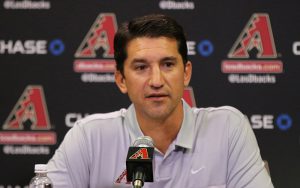- Slug: Sports-Diamondbacks farm system, 650 words.
- Photo available
By EDDIE POE
Cronkite News
PHOENIX — If anyone asks what’s most pertinent to a successful Major League Baseball organization, a simple answer is depth. For the new front office of the Diamondbacks, rebuilding the depth of its farm system is near the top of its to-do list.
“They need arms, they need bats, they need athletes … they need it all,” John Manuel, Editor-in-Chief of Baseball America, said in a phone interview before this year’s draft.
“They’re thin everywhere,” he said. “They could use talent in all areas of the organization.”
In an Insider piece earlier this year, ESPN senior baseball writer Keith Law rated the Diamondbacks’ minor league system as the worst in baseball. He suggested that the organization had a thriving farm system prior to the arrival of Dave Stewart as general manager. In 2016, he also remarked openly in an Insider piece, saying, “The front office is a laughingstock.”
During Stewart’s two years with the organization, Arizona was widely accused of drafting poorly and the best player selected during his tenure — Dansby Swanson — is now the starting shortstop for the Atlanta Braves. He was part of a trade for Shelby Miller that was universally ridiculed and attributed to the partial gutting of their minor-league system.
Pitching prospect Aaron Blair was also part of the trade in exchange for Miller and was rated as one of the organization’s top two prospects during the 2015 offseason, along with Swanson.
“It’s a farm system that was gutted by the previous administration,” Manuel said. “What they really need is ownership to give the front office the time to implement a philosophy and to allow it time to bear fruit.”
That new philosophy was highlighted by Arizona’s top draft picks this year and has provided members of the organization with a refreshing outlook of the future.
Scouting Director Deric Ladnier has been with the Diamondbacks since 2014, and is already accrediting the philosophy of the new administration.
“The blend of traditional scouting and analytics was unique and new to me,” Ladnier said on a conference call with reporters following the conclusion of this year’s draft. “I know at the end of the day this blend is only going to allow us to continue to have deeper drafts and put more prospect players in the organization.”
Ladnier heads a scouting department that has made successful picks in the past but has been led by a front office that has created instability.
Organization talent rankings produced by Baseball America rates the Diamondbacks at 28th out of 30 MLB teams in 2017. That’s up from 22nd in 2016 and 6th in 2015 and is a clear indication of the damage done by the previous administration.
First-year GM Mike Hazen and assistant GM Amiel Sawdaye have a track record of success during their time with the Boston Red Sox, helping to replenish a farm system as one of the best in baseball. Blake Swihart, Mookie Betts, and Jackie Bradley Jr. were among the 2011 draft picks that some have considered the best draft class ever.
“(Mike and Amiel) aren’t afraid to go after guys with ceiling,” Manuel said. “Right now, the organization needs it.”
With their first three picks in this year’s draft, the Diamondbacks selected three established collegiate hitters, a far cry from the top of past drafts. The 38 other players that were selected by Arizona were also largely decided on by the blend of analytics and the organization’s traditional drafting methods.
When it’s all said and done, replenishing the farm system will require innovative ideas. For now, the fresh faces in the front office are prepared to do just that.
“The game has changed and it would be crazy of us not to utilize the tools that are given to us,” Ladnier said. “The application of it is the key in being able to blend the traditional scouting with analytics, and that’s what we did.
“It was a collaborative team effort.”
